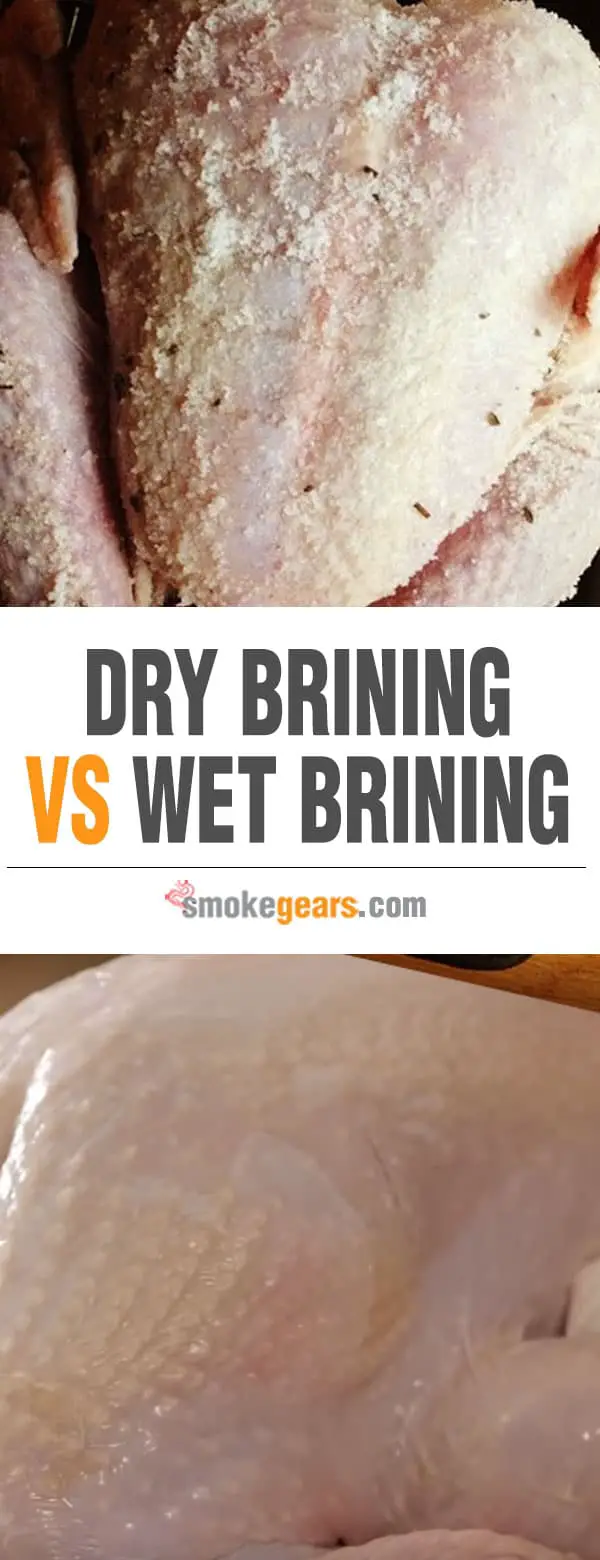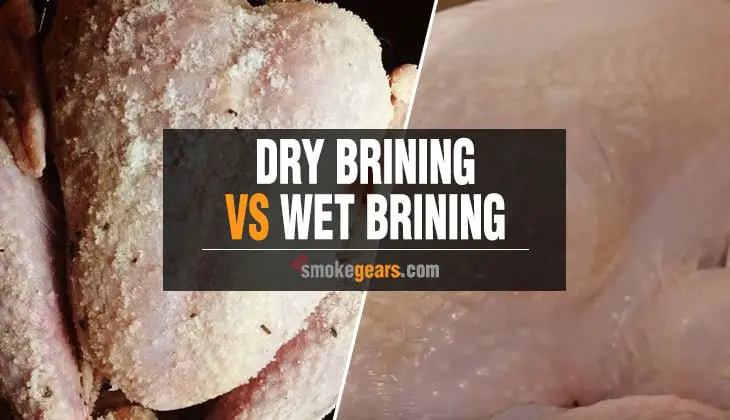Dry Brining vs Wet Brining – What to Go For?
As we all know, brining increases the flavor as well as preserve meat. Using salt is an ancient technique for storing food.
However, there are different types of brining. Most people have a bit of confusion regarding the differences between dry brining and wet brining.
And that’s what our article is about.
Today, we will attempt to clear all your confusions regarding both types of brining. For we will be going through the ins and outs of each process and bring you all the information you need about them.
So without further ado, let’s dive into the topic.
More...
What is Brining?
For the uninitiated, brining meat or fish is an ancient technique of food preservation. Before the modern era, brined or salt-preserved fishes or meats were taken on long sea expeditions and military campaigns as there was no refrigeration system available then.
Nonetheless, in the present day, brining comes up with a new purpose.
Surprisingly, nowadays, brining has turned out to be a fantastic cooking method that puts a significant impact on the overall quality of your food. And thankfully, it's elementary. By adding lesser quantities of salt mixed with other spices, brining can make the meat taste fantastic.
Brine is a cooking term used for salty water that preserves and adds extra flavor to different kinds of food. For the desired result, the salt can only be used to brine foods without adding water.
Science Behind Brining
The art behind brining is effortless. Brining is performed by submerging meats in a liquid with a higher concentration of salt. When you keep salt and meat together, the salt went inside the center of the flesh.
In other words, brining is adding salt on meat or keeping meat down into salty water and allowing that saltwater to go through some natural processes. The good thing about this fantastic process is that you can add other herbs, spices, flavorings, etc. with the salt to make the food taste more delicious.
Reason Behind Brining
In one sentence I can say, brining meat improves the flavor as well as increases the moisture intensity inside the meat or the fish. During the cooking time, moisture goes out of the food. As a result, the meat becomes more dried and hard to eat once it is cooked.
But thankfully, brined piece of meats have extra moisture inside and therefore ends up being more juicy and moist than regular meat. Moreover, in early days, brine techniques are used to preserve food from turning into rotten waste as there were no refrigerators available then.
However, in our times, cooking experts have discovered that brined meat adds extra taste into the meat, and it tastes extraordinary!
Wet Brining Vs Dry Brining
There are mainly two types of brining available. One example is Wet brine, while another kind is dry brine. Some people prefer dry option, while others like the wet one.
In the following section of the article, I will be discussing what wet and dry brine are, the process of making both types of brining, their pros and cons. So, you can thoroughly understand the concept of both types of brining and choose the best for you.
Dry Brining
The basic idea of dry brining is to rub the piece of meat with a mixture of salt and spices before cooking it. Behind this easy process lies a handy formula which is master at transforming the tenderness and flavor of your delicious barbecued dishes.
In the case of dry brining, which is accomplished by using dry components only, you don’t need to place the meat in the refrigerator for a whole night, or perhaps more, nor the possibility of watering down or washing away its essence.
As a result, the inner moisture of the meat remains unchanged, as well as its mouth-watering taste. This process makes any skin - such as chicken skin entirely appetizing and crisper indeed.
How Dry Brining Works?
The dry brining principle is that when an external coating of salt along with spices (optional) is formed, these covering materials infiltrate the fibers of the meat.
When you start cooking the meat, it expels its moisture in the direction of the external surface and accumulates on the outside layer of meat. As the cooking progress, some of the humidity again goes into the fiber.
This system is also known as "push and pull." These reactions improve the taste of meat with the essence of salt and spices, but without diluting its natural flavor. With the dry brining technique, you can prepare the meat in a few minutes before cooking, and you are ready to go.
The Procedure of Dry Brining
The size and shape of the meat matters when you dry brine it. A bulkier and rounder thick-cut will take more time than a longer, wider, but thinner cut. So a chuck roast requires less time than an equally sized rump roast. A properly cut chicken or turkey will take less time than a whole turkey or chicken. Regulate your timing for brining accordingly.
Don’t worry. Here’s some information about how long you will need to dry brine different cuts of meat before cooking.
Note: You can also keep your dry brined meat longer in the brined state. The given times above are minimums to assist you in ensuring perfection. As long as you applied adequate salt and spices, and the meat piece was not rotten before dry brining, it will keep the meat safer.
Now let’s move to step by step procedure of dry brining-
Why Should You Choose Dry Brining?
Dry brine technique saves your time as it cooks faster. Moreover, it is a straightforward process and very easy to learn. The dry brining process also cost little. If you want to make the thanksgiving dish more delicious with less time, you should go for this process.
Advantages of Dry Brining:
Disadvantages of Dry Brining:
Wet Brining
Wet brining is the method that will result in the juiciest meat ever! It is a procedure involving plenty of water and cups of salt. Moreover, wet brining adds extra moisture to your foods, especially meats. This technique is called wet brine because water or other liquid are used in the process.
Apart from breaking down proteins, a wet brine method lock in additional water in the muscle fibers of meats, which further decreases the amount of moisture lost at the time of cooking. In a sentence, we can say, wet brining is the system of submerging meat in a saltwater solution.
What is more, you can include things other than salt for more taste, but to get going all you need is H2O (water) and NaCl (sodium chloride or salt).
How Wet Brining Works?
Here, I will discuss what happens when you brine food, such as meat. If you know what's going on, it will be easier to adapt the system according to your taste or employ it to a new circumstance.
Two main natural processes go on while wet brining occurs:
• Diffusion
This is while particles shift from an area of higher concentration to a region of lower concentration. For instance, when you are wet brining a chicken, the brine mixture got more salt in it than the chicken. As a result, the salt is absorbed by the chicken.

• Osmosis
Osmosis happens when water (or other liquid) goes through a membrane from one place that has more water to another area that has less water. When you wet brine meat or fish, you are merely creating just that condition mentioned above of osmosis.
Everything is about keeping things in balance! Isn’t it?
Along with diffusion and osmosis, there's another phenomenon happen when you wet brine meat. When the salty water mixture goes inside the flesh, it compels some of the proteins molecules to loosen.
Then, when you steam the meat, these proteins interact with each other by creating one kind of guard that keeps the moisture stay inside.
The Procedure of Wet Brining
The percentage of salt to water is the most significant part of the wet brine process. Generally, I would suggest you add 1 cup of salt for each gallon of water. A 10 to 12 lbs meat such as turkey will require 2 gallons of water with 2 cup salt to completely immerse the meat.
Garlic, bay leaves, peppercorns, and herbs are commonly used items in wet brines, too. You can also use 1/4 cup of sugar for every cup of salt. And most importantly, don’t forget to boil these selected ingredients to get the most out of them.
You have to wet brine meat for a long time to let the salty solution properly reach the deepest part of the flesh. But be aware! Never moisten brine meat for too long as it can result in tasteless soggy meat.
Now let’s discuss the process of wet brining -
Why Should You Choose Wet Brining?
If you want juicer and soft meat for your special dish then you should wet brine your meat. It not only makes the meat tastier but also healthy for our body. Moreover, it is perfect for beef or chicken curry.
Advantages of Dry Brining:
Disadvantages of Wet Brining:
Which One to Choose?
It is tough to declare a winner as both wet brine, and dry brine is applied for two different types of purpose. The wet brine provides juicier meat for your curry while dry brine is better for making grilled meat.
However, both brining methods have their benefits and drawbacks. If you make your mind up to wet brine meat, you need a large segment of your fridge to house a huge container full of salt water and raw meat. Or, if you want to dry brine meat, you still need to give up some space but for a small quantity of time.
But, if you consider time, space, and simplicity, then I would suggest you go for dry brine because wet brine needs more space and is not a straightforward brining technique. And if you are brining meat for business purpose, then dry brining should be your ultimate choice.
Conclusion:
Preparing brine is simple; however, it needs to wait for a while to allow the salt to do its work. With a little bit of space and planning, soft and moist meat can be achieved easily.
After all, the selection to dry brine vs wet brine method depends on how much room you can allot, how much time you have to complete the procedure, and most importantly, just how much effort you are willing to give to make a well-cooked delicious dish.


